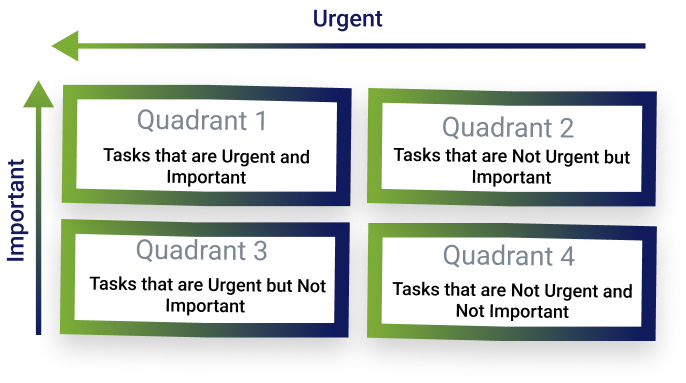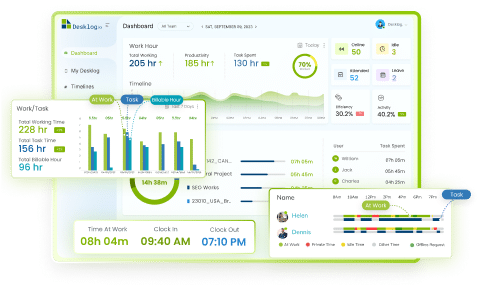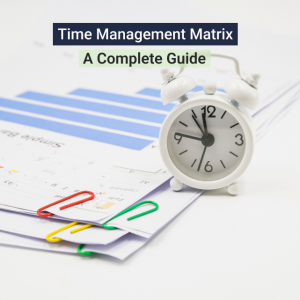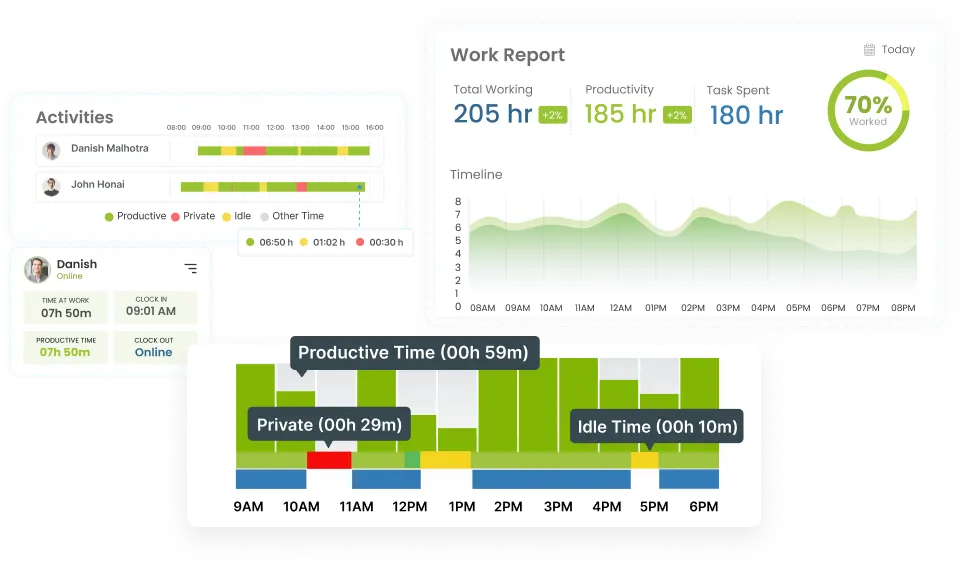Who in the world holds the reins of time? We all seem to be prisoners of its relentless march, a cycle that ultimately concludes with the end of our lives. Have you ever felt trapped in this loop, believing that there’s never enough time to enjoy life or complete your work? According to studies, each of us has roughly 29,200 days in our lifetime, and after deducting about eight hours of sleep daily, that leaves us with around 19,466 days. Are you truly using those days effectively? Probably not, right?
Time management is often viewed as an elusive fruit, something we strive for but rarely attain. However, this perception is misguided. There are several time management matrices that can aid in better planning, helping us balance our responsibilities without overcommitting or underperforming.
Have you heard about time tracking software? These days, it’s becoming increasingly familiar to everyone due to its widespread adoption. This shift indicates that many of us are beginning to think differently about time management and its significance. Time management isn’t just for the workforce; you can also optimize your personal time using time tracking software.
Do you need to change your time game? If it’s a yes, let’s learn some intriguing facts about the time management matrix and how the fusion of these tools can help resolve our time-related challenges.
What is the Time Management Matrix?
The Time Management Matrix, often referred to as the Eisenhower Matrix, is a powerful tool for prioritizing tasks based on their urgency and importance. This framework divides tasks into four quadrants, allowing individuals to clearly identify which activities align with their goals. By emphasizing the distinction between urgent and important tasks, the matrix guides users to focus on what truly matters, increasing productivity and effective planning. Originally articulated by Dwight D. Eisenhower, a U.S. President and World War II general, this method has been widely adopted by individuals and organizations seeking to optimize their time management strategies.
Stephen Covey later popularized this matrix in his influential book, “The 7 Habits of Highly Effective People.” Covey expanded on Eisenhower’s insights, helping people discern between tasks that demand immediate attention and those that contribute to long-term objectives. The matrix not only aids in task prioritization but also encourages a more thoughtful approach to managing one’s time. As a result, many businesses and personal productivity systems have integrated this concept, using it to minimize distractions and improve overall efficiency.

The Concept of the Four Quadrants of the Time Management Matrix
We have learned that the Time Management Matrix is used to prioritize tasks by categorizing them into four distinct quadrants. Understanding this classification is important for gaining better productivity using a better time matrix. The Time Matrix classification is based on the urgency and importance of tasks, providing a clear framework for effective task management and increased productivity.
In simple words; the first quadrant focuses on tasks that are both urgent and important, requiring immediate attention. The second quadrant consists of significant tasks that are not urgent but essential for long-term success. The third quadrant includes tasks that are urgent yet not particularly important, while the fourth quadrant encompasses activities that are neither urgent nor important. Utilizing this matrix effectively can significantly improve planning skills and time management.
Time Management Matrix: Break Down of 4 Quadrants

Quadrant 1: Urgent and Important:- Managing Crises and Emergencies Effectively
In this quadrant, individuals must address tasks that are both urgent and important, such as critical deadlines, pressing problems, and unforeseen emergencies. Spending excessive time in this quadrant can lead to burnout and a continuous cycle of crisis management. It’s crucial to regularly assess why tasks become urgent and seek ways to prevent such situations from arising in the first place. This reflective practice helps identify underlying causes and promotes a more proactive approach to workload distribution management. For instance, if an unexpected fire alarm disrupts an important meeting, the urgent need to address the fire takes precedence, illustrating how urgent tasks can overshadow planned activities.
Quadrant 2: Urgent But Not Important:-
This quadrant comprises tasks that require immediate attention but do not significantly impact long-term goals. Common examples include unnecessary meetings, phone calls, and various interruptions. Minimizing time spent in Quadrant III is crucial for maintaining focus and productivity. Strategies such as delegating or outsourcing these tasks can free up valuable time and energy. For instance, using software to manage routine tasks like attendance tracking can allow employees to concentrate on more strategic responsibilities. Identifying and prioritizing these less significant urgent tasks helps keep the focus on what truly matters.
Quadrant 3: Urgent But Not Important:- The Stage of Diversion & Breaks
This quadrant comprises tasks that require immediate attention but do not significantly impact long-term goals. Common examples include unnecessary meetings, phone calls, and various interruptions. Minimizing time spent in Quadrant III is crucial for maintaining focus and productivity. Strategies such as delegating or outsourcing these tasks can free up valuable time and energy. For instance, using software to manage routine tasks like attendance tracking can allow employees to concentrate on more strategic responsibilities. Identifying and prioritizing these less significant urgent tasks helps keep the focus on what truly matters.
Quadrant 4: Not Urgent and Not Important:- The Loop of Unproductive Time
Quadrant IV consists of activities that are neither urgent nor important, often regarded as time-wasters. Examples include excessive social media use, aimless browsing, and non-essential entertainment. While some leisure activities are necessary for balance, spending too much time in this quadrant can lead to procrastination and drain energy. Recognizing these tasks as low-priority helps individuals minimize their occurrence. It’s important to manage time effectively by limiting engagement in Quadrant IV activities, allowing for a more focused and productive approach to daily responsibilities. Reducing the time spent in this quadrant can significantly improve overall effectiveness and well-being.
Let’s learn about 20 management tools to manage work life balance.
Why Do You Need a Time Management Matrix for Success?
Utilizing a time management matrix offers numerous advantages that contribute to a more organized and productive work routine.

Increased Productivity
By implementing the matrix, individuals can significantly boost their productivity. It provides a structured approach to prioritizing tasks, allowing you to concentrate your efforts on high-priority activities. This focused categorization results in more efficient and effective outcomes.

Improved Task Prioritization
The matrix helps clarify the urgency and importance of various tasks, enabling better prioritization. This understanding allows individuals to allocate their time and resources more effectively to activities that align with their overall goals, minimizing the risk of getting sidetracked by less important tasks.

Lower Stress Levels
With better prioritization and a proactive approach to managing time, individuals often find their stress levels decrease. By tackling critical tasks in a timely manner and avoiding last-minute emergencies, the overall workload becomes more manageable, contributing to a healthier work-life balance.

Greater Accountability
Using a time management matrix encourages personal accountability. When tasks are clearly categorized, individuals are more likely to take ownership of their responsibilities and follow through on commitments, leading to improved reliability and trust among team members.

Improved Decision-Making
The matrix aids in making informed decisions about where to invest time and energy. By distinguishing between what is urgent and important, individuals can choose actions that lead to better outcomes, ensuring that time is spent on activities that provide the greatest benefit.

Promotion of Long-Term Goals
Focusing on Quadrant II tasks, those that are important but not urgent encourages personal and professional growth. This strategic planning fosters the development of skills and relationships that contribute to long-term success.

Increased Work-Life Balance
By effectively managing time and prioritizing tasks, individuals can create boundaries between work and personal life. This improved work life balance helps prevent burnout and allows for more time to be spent on personal interests and relationships.

Adaptability and Flexibility
Regularly reviewing the matrix allows for adjustments based on changing priorities or unexpected events. This adaptability enables individuals to respond effectively to new challenges while maintaining focus on their primary goals.

Better Team Collaboration
When teams utilize a time management matrix, it increases collaboration by providing a shared framework for task prioritization. This alignment ensures that everyone is on the same page, leading to more cohesive teamwork and project success.
Incorporating a time matrix into your routine not only simplifies task management but also fosters a proactive approach to achieving personal and professional success.
Do you know about the pros and cons of work from home? Let’s find out what they are.
Practical Application of the Time Management Matrix
To effectively utilize the Time Management Matrix, consider the following strategies to improve your task management and productivity:

Regular Review and Adjustment: Allocate time each week to assess your matrix. This review process allows you to adjust your priorities as new tasks arise and circumstances change. Keeping your matrix current ensures you’re always focusing on what matters most.

Prioritize Quadrant II: Make it a point to spend more time on tasks that are important but not urgent. Activities such as strategic planning, skill development, and relationship building can significantly impact your long-term success. By prioritizing these tasks, you can reduce the likelihood of last-minute crises.

Delegate Tasks When Possible: Identify tasks in Quadrant III that consume time without adding significant value. Delegating these tasks allows you to concentrate on higher-priority responsibilities. Empowering team members to take on these tasks can increase overall productivity.

Minimize Distractions: Actively work to reduce the time spent on Quadrant IV activities, such as aimless social media scrolling or binge-watching. Set boundaries for the workplace distractions by using apps that block access during work hours, ensuring your focus remains on more important tasks.

Leverage Technology: Utilize productivity tools like Confluence or Trello to manage tasks, facilitate team collaboration, and maintain a clear project scope. These technologies can simplify your workflow, keep you organized, and improve communication with your team
Implementing the Time Management Matrix in Your Daily Routine
Step-by-Step Guide for Categorizing and Scheduling Tasks:

List Your Tasks
Start by writing down all the tasks you need to complete, regardless of their perceived importance or urgency.

Categorize Tasks
Use the four quadrants of the Time Management Matrix to classify each task:
-
Quadrant I: Urgent and Important
-
Quadrant II: Important but Not Urgent
-
Quadrant III: Urgent but Not Important
-
Quadrant IV: Not Urgent and Not Important

Prioritize:
Focus first on tasks in Quadrant I, followed by Quadrant II. Schedule dedicated time for Quadrant II activities to ensure they receive the attention they deserve.

Set Deadlines:
Assign realistic deadlines for each task, particularly for those in Quadrant I and II. This creates a sense of urgency and helps maintain accountability.

Review and Adjust:
At the end of each day or week, review your progress. Adjust your matrix as needed based on completed tasks and emerging priorities.
Customizing the Matrix for Your Role or Industry:
Identify Industry-Specific Tasks:
Tailor the tasks within the quadrants to reflect the unique demands of your role or industry. For example, a marketing professional might focus on content creation in Quadrant II, while a project manager might prioritize stakeholder communication.
Incorporate Team Goals:
If working within a team, integrate collective objectives into the matrix. This ensures alignment and encourages collaboration on tasks that impact both individual and team success.
Reflect on Industry Trends:
Regularly update your matrix to account for shifts in industry trends or changes in project scope. Staying adaptable ensures your focus remains relevant and effective.
By following these guidelines, you can implement the Time Management Matrix into your daily routine, leading to improved productivity and a more organized approach to your tasks.
We know you are still counting how many working days in a month. Here’s your guide.
Overcoming the Challenges with Time Management Matrix
Implementing a time management matrix can significantly increase productivity, but it also comes with its own set of challenges. Recognizing these obstacles is the first step toward effective time management. By employing specific strategies, individuals can find these challenges and maximize the benefits of the matrix. Let’s find the most common challenges in the implementation of the time matrix and then we will learn about the accurate solutions for it.
Common Challenges When Implementing the Time Management Matrix
When using a time management matrix, several common challenges can block its effectiveness. By being aware of these challenges and proactively addressing them, you can improve the effectiveness of your time management matrix and improve your overall efficiency and avoid toxic productivity activities. Let’s review the challenges;
Difficulties in Balancing Quadrant I and Quadrant II Tasks
Striking the right balance between urgent and important tasks (Quadrant I) and important but non-urgent tasks (Quadrant II) can be challenging. Often, urgent tasks demand immediate attention, which can lead to neglecting essential activities that contribute to long-term success. It’s crucial to allocate time for strategic planning and personal development to ensure a well-rounded approach to task management.
Dealing with Unpredictable Urgent Tasks
Unexpected urgent tasks can disrupt even the best-laid plans. These unforeseen demands can create a constant state of urgency, making it difficult to focus on other important activities. Developing a strategy for handling these surprises; such as setting aside time for contingencies can help maintain a sense of control and balance in your schedule.
Neglecting Quadrant II
Focusing too heavily on urgent tasks (Quadrants I and III) often leads to overlooking important but non-urgent activities in Quadrant II. This neglect can prevent strategic growth and long-term planning opportunities. It’s essential to dedicate time for Quadrant II tasks to ensure ongoing progress toward your goals.
Becoming Too Rigid
While having a structured approach is beneficial, being overly rigid in categorizing tasks can limit flexibility. The nature of tasks can evolve, so it’s important to remain adaptable. Regularly reassessing and adjusting your matrix based on changing priorities will help keep your task management relevant.
Failing to Delegate
Many individuals find it difficult to delegate tasks, especially those in Quadrant III. This reluctance can lead to an overwhelming workload and decreased efficiency. Learning to trust your team and assign less critical tasks can free up time to focus on what truly matters.
Ignoring Regular Reviews
Neglecting to conduct regular reviews of your time management matrix can result in outdated task lists. Setting consistent review intervals ensures that your priorities align with your current goals, allowing for adjustments as needed.
Getting Caught in Quadrant IV
Spending too much time on low-priority tasks (Quadrant IV) can lead to significant productivity losses. It’s essential to limit distractions and redirect your focus toward more valuable activities that contribute to your overall objectives.
Solutions for Effective Matrix Implementation
Understanding the time management matrix is just the beginning; successfully integrating it into your daily routine requires a strategic approach. Here’s a concise guide for optimal results:

Identify All Tasks:
Compile a complete list of tasks, including work assignments, personal responsibilities, and other commitments.

Categorize Tasks:
Sort these tasks based on urgency and importance, placing them in the appropriate quadrants of the matrix for a clear overview.

Prioritize Tasks:
Focus on Quadrant I tasks first, followed by Quadrant II activities that support long-term goals, ensuring efficient use of your time.

Create a Schedule:
Develop a daily or weekly schedule that allocates specific time blocks for tasks from each quadrant, balancing urgent and important activities.

Stay Flexible:
Be prepared to adapt your schedule as unexpected events occur and priorities change, keeping your overall goals in mind.

Use Distraction Blockers:
Implement techniques to minimize interruptions during focused work periods, improving your time management effectiveness.
There are different work schedules you can adapt for better time management
Bring Effective Time Management With Desklog
Incorporating time tracking tools like Desklog alongside the time management matrix can provide better futuristic productivity and organization. Here’s how Desklog supports the essential principles of effective time management:
Automated Time Tracking
Automated time tracking features like idle time tracking and offline time tracking ensure accurate reporting of productive versus unproductive periods. Idle time tracking helps identify areas for improvement, while offline time tracking captures work done without internet connectivity, ensuring no productive moments go unaccounted for.
Task & Project Management
Task and project management functionalities help organize and prioritize tasks within projects, enabling effective resource allocation and collaboration. These tools provide a holistic view of project time tracking and its progress, ensuring that all aspects are aligned for successful completion.
Screenshot and Keystroke/Mouse Activity Tracking
Screenshot tracking captures periodic images of the user’s screen, providing insights into work patterns and productivity levels. Keystroke and mouse activity tracking assess the usage to analyze user engagement and efficiency, helping identify productivity trends and potential distractions.
Shift Schedule
Shift scheduling manages and organizes employee schedules, facilitating better workforce planning and ensuring adequate coverage. And also improves the employee efficiency and productivity.
In Summary,
In conclusion, the Time Management Matrix is an invaluable tool for increasing productivity and achieving a balanced life. By categorizing tasks into four quadrants urgent and important, important but not urgent, urgent but not important, and neither urgent nor important you can prioritize effectively and focus on what truly matters.
Following this matrix not only helps in making informed decisions about how to allocate your time but also fosters personal growth and reduces stress. As you integrate these principles into your daily routine, you’ll find yourself more organized, purposeful, and ultimately more successful in reaching your goals. Remember, effective time management is not just about getting more done; it’s about making time for what counts.
FAQ
1 What is a time management matrix?
A time management matrix is a tool used to prioritize tasks based on their urgency and importance, helping individuals allocate their time effectively.
2What are the four quadrants of the time management matrix?
The four quadrants are:
-
Quadrant I: Urgent and Important
-
Quadrant II: Not Urgent but Important
-
Quadrant III: Urgent but Not Important
-
Quadrant IV: Not Urgent and Not Important
3How do I use the time management matrix?
List your tasks, categorize them into the four quadrants, and focus on Quadrant II for proactive work while managing Quadrant I tasks as they arise.
4Why is Quadrant II important?
Quadrant II focuses on long-term goals and planning, helping prevent crises by allowing time for important but not urgent tasks.
5What should I do with tasks in Quadrant III?
Delegate or minimize these tasks, as they are often distractions that can consume valuable time without contributing significantly to your goals.
6How can I avoid spending too much time in Quadrant IV?
Identify and eliminate time-wasting activities by setting clear goals and boundaries around your schedule.
7Can the time management matrix help with stress management?
Yes, by prioritizing tasks and reducing the feeling of being overwhelmed, the matrix can help lower stress levels and improve focus.
8Is the time management matrix suitable for team use?
Absolutely! Teams can use it to align priorities, ensuring everyone is focused on the most impactful tasks together.
9How often should I revisit my time management matrix?
You should revisit your time management matrix regularly, ideally daily or weekly, to adjust priorities based on new tasks and changing goals. This helps maintain clarity and focus, ensuring you stay aligned with your long-term objectives.
10Are there digital tools to create a time management matrix?
Yes, many apps and project management tools offer features to create and manage time management matrices digitally for easier tracking.


















This is a well-explained and comprehensive introduction to the Time Management Matrix. The breakdown of each quadrant makes it easy to understand how to prioritize tasks effectively. A great read for anyone looking to take control of their time and boost productivity!